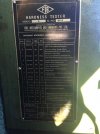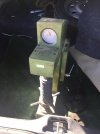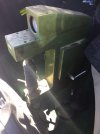KnuckleDownKnives
Time to make the doughnuts..
- Joined
- Feb 12, 2015
- Messages
- 1,715
Well I'm i need of getting an O1 knife tested because after HT, 18 mins at 1475-1500 and quench in 125* canola oil it seems a file is biting in some and it's my first O1 to go out the door and I want it right. I contacted JT and he's up for it but the time to get it to him in back if it tests good is putting me well over time what I told my customer I could get it to him in. So yesterday I called around and found a shop 3 miles from my work that has a tester, but recommended me contacting the tech collage 1/2 mile from my office. So after trying to contact them for the last 2 days to no avail, I call the first shop back and he's going to test it for me tomorrow. He also said he has their old tester that worked up until the day they got their new one and will sell it to me if I want for $50.00. He said it tests in C scale and is a diamond tip tester and has all the parts. So for $50 I'm going to chance it and pick it up either way. Worst case scenario I'll have a $50 paper weight...



